Abstract
Recent studies on immunity to helminthic infection have shown that some degree of protective immunity may be stimulated by inoculations of attenuated living worms or their metabolites. The present experiments were designed to observe the effects of attempted immunization in the rhesus monkey by the use of attenuated infective larvae of Brugia malayi.
Some effect was observed in animals inoculated with larval incubate, in which microfilaraemia did develop, but at low levels and for short durations. However, the most strking finding was that persistent immunity to challenge infections (expressed as failure to cause microfilaraemia) was obtained in animals vaccinated with large numbers (200) of infective larvae attenuated by X-irradiation at 20 000 R.
Experiments with different numbers of larvae attenuated by different doses of irradiation suggest that there is an optimum combined effect of these two factors in eliciting functional antibody in a quantity sufficient to prevent patent infection in Malayan filariasis.
Full text
PDF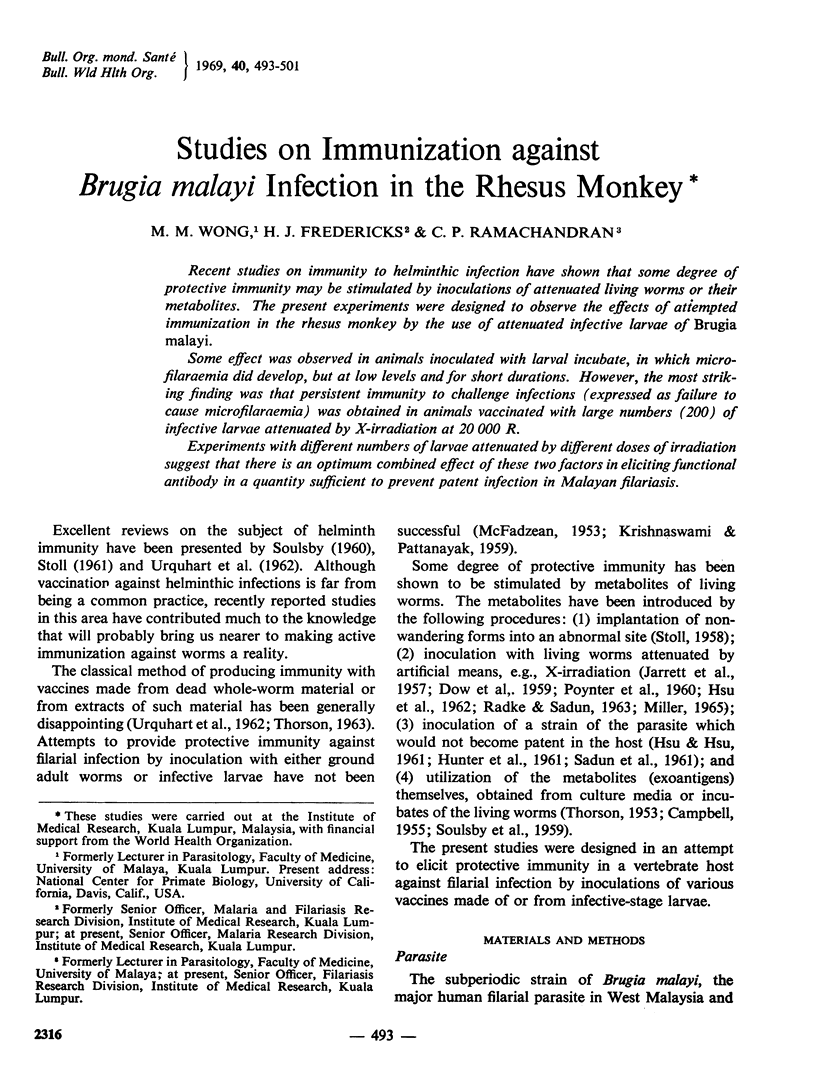
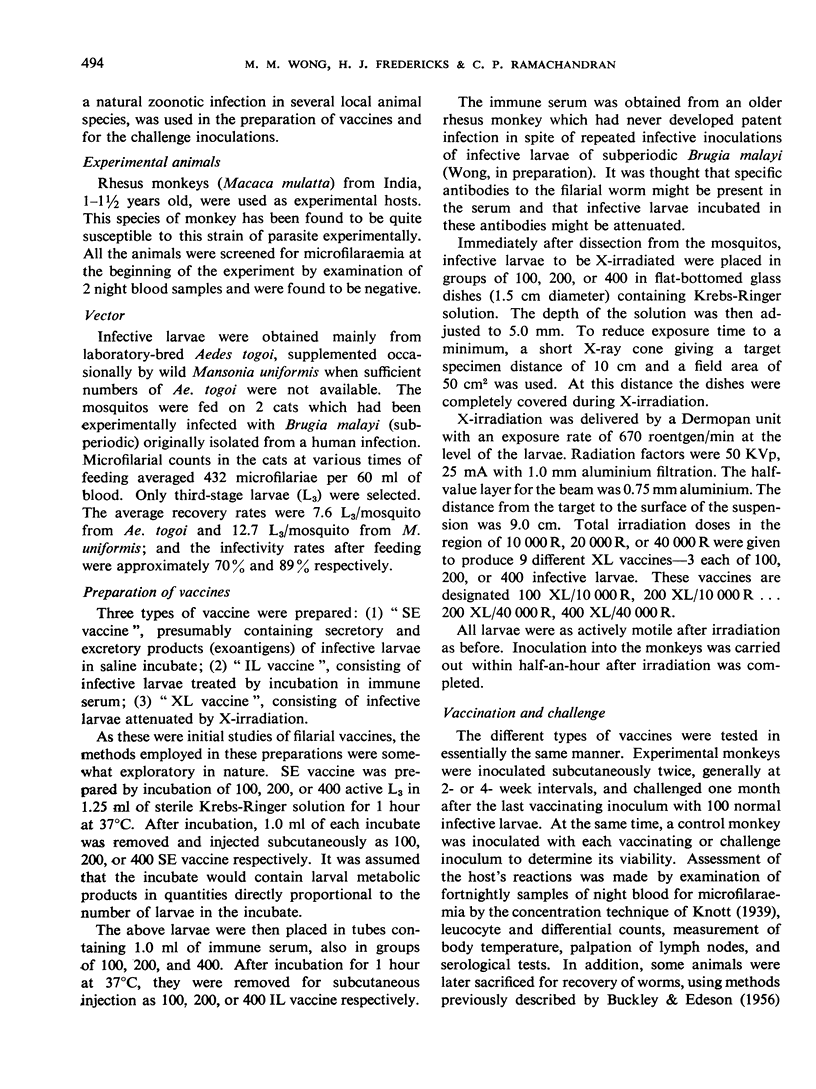
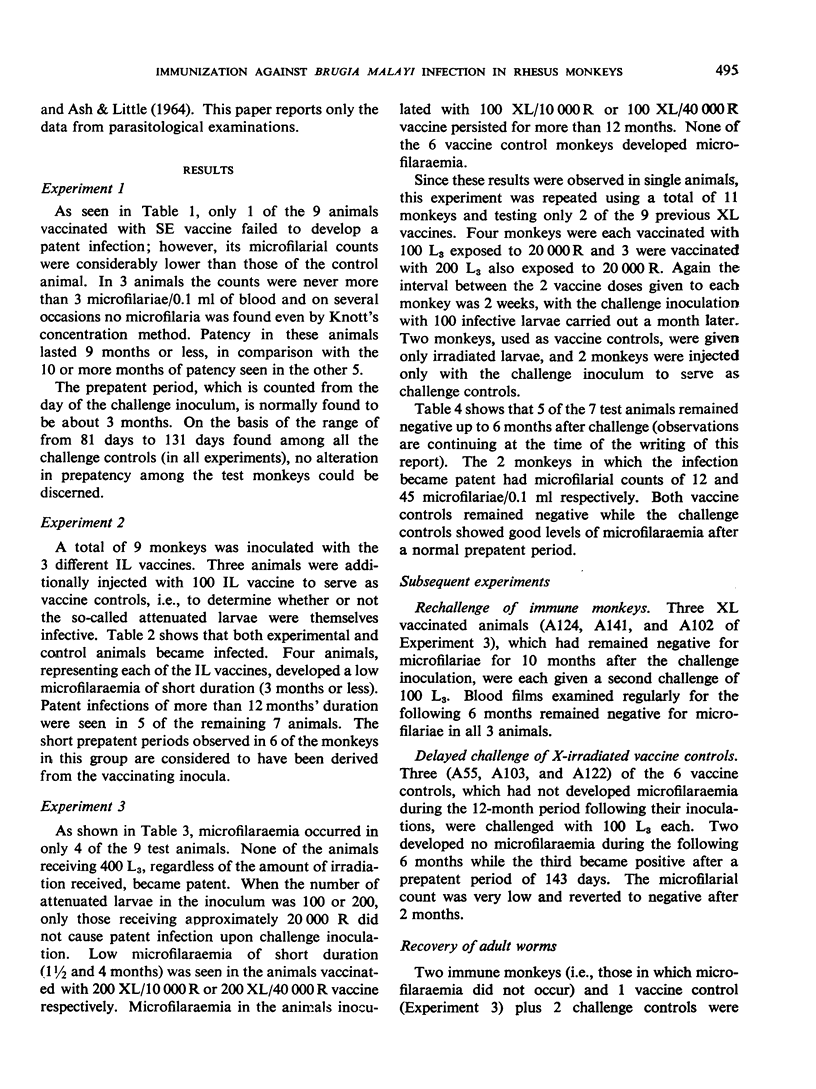
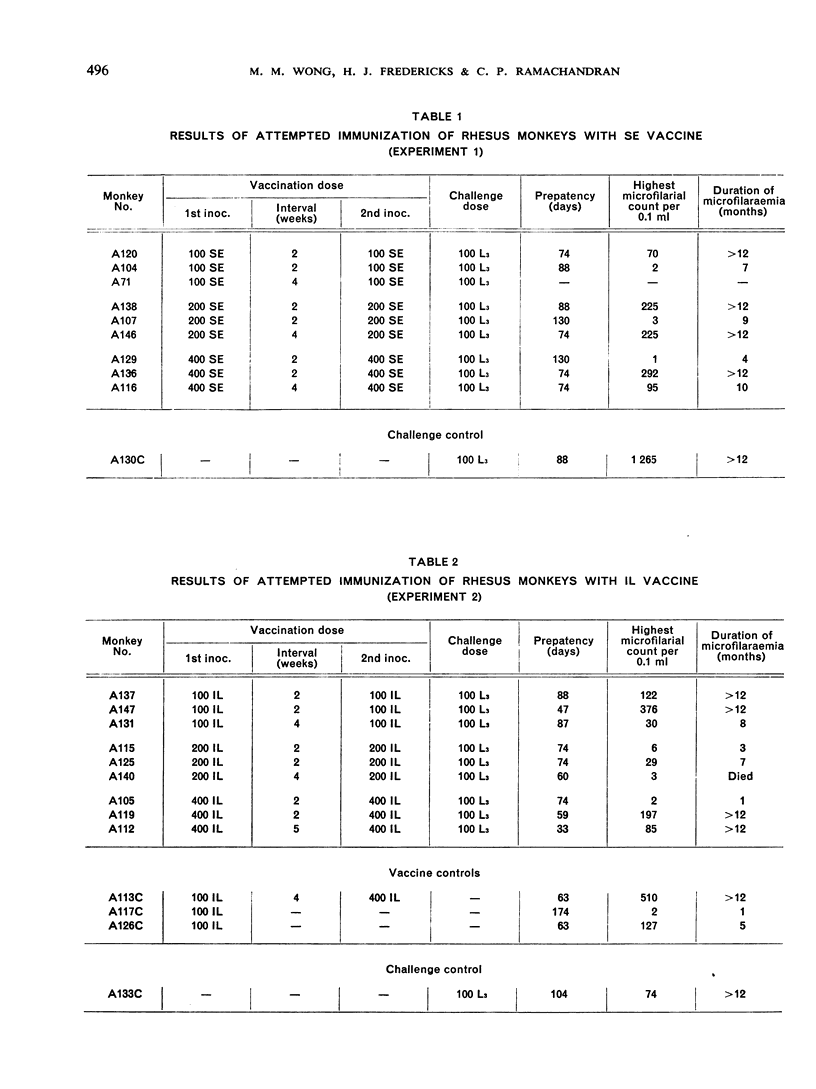
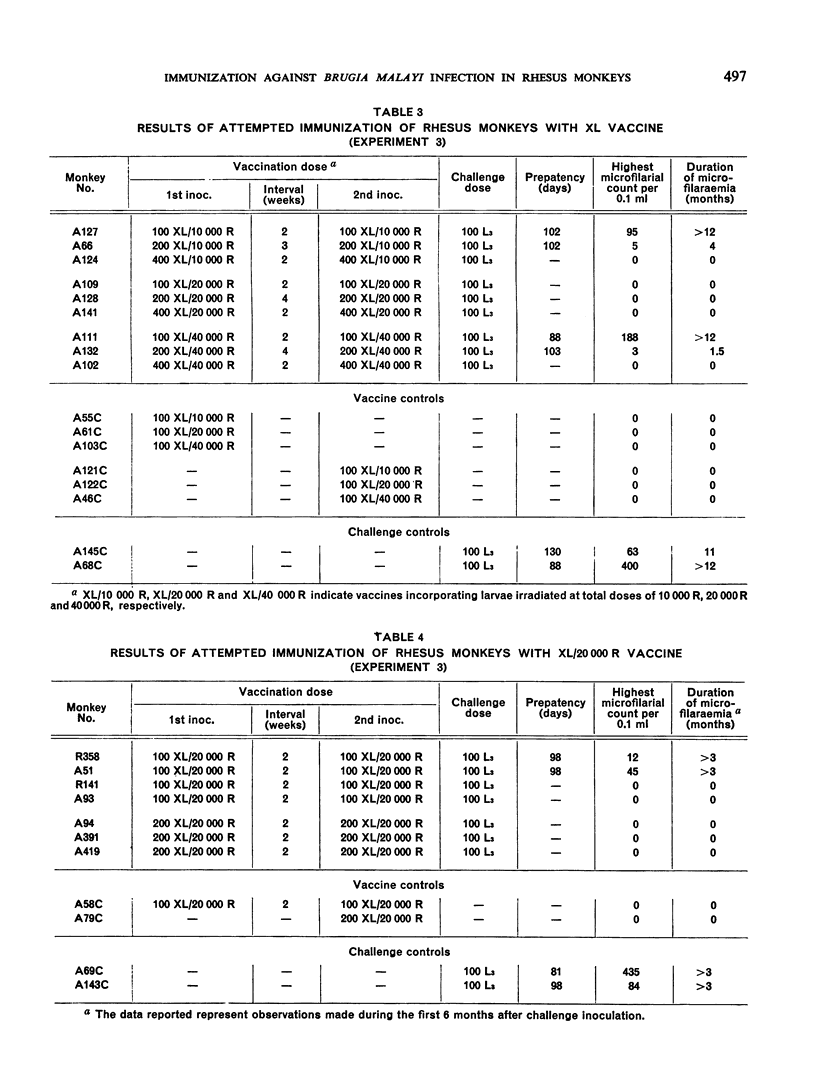
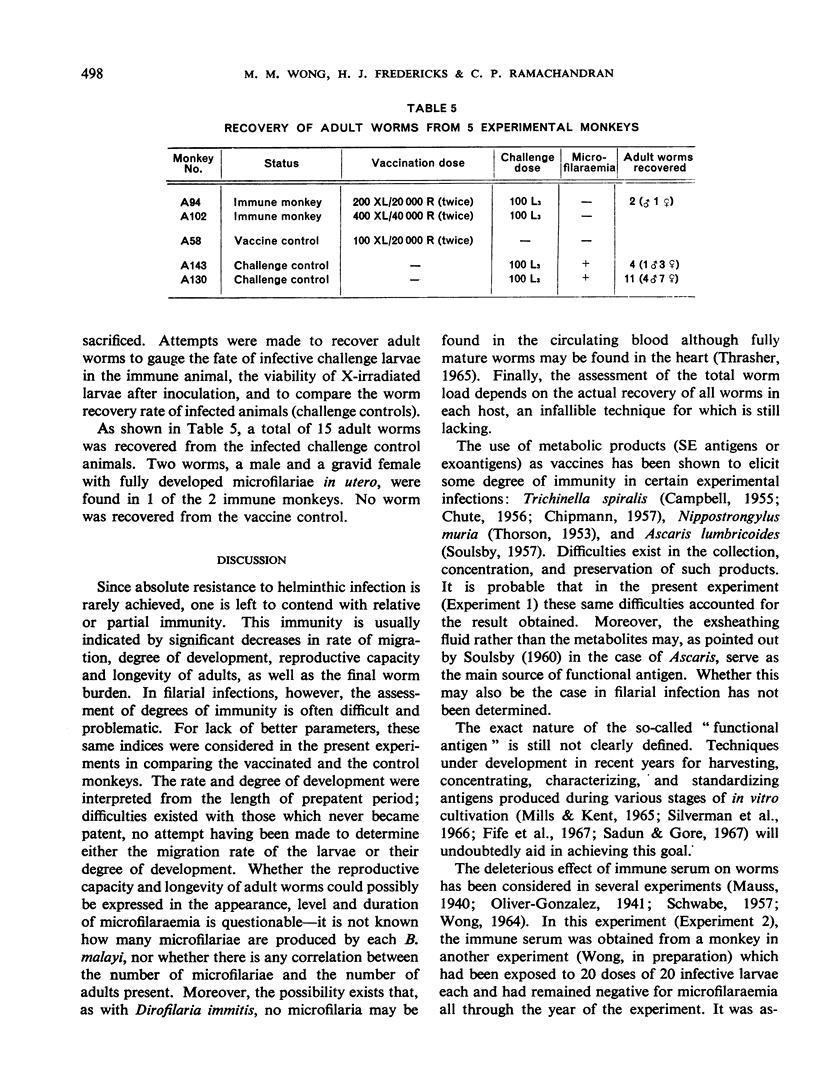
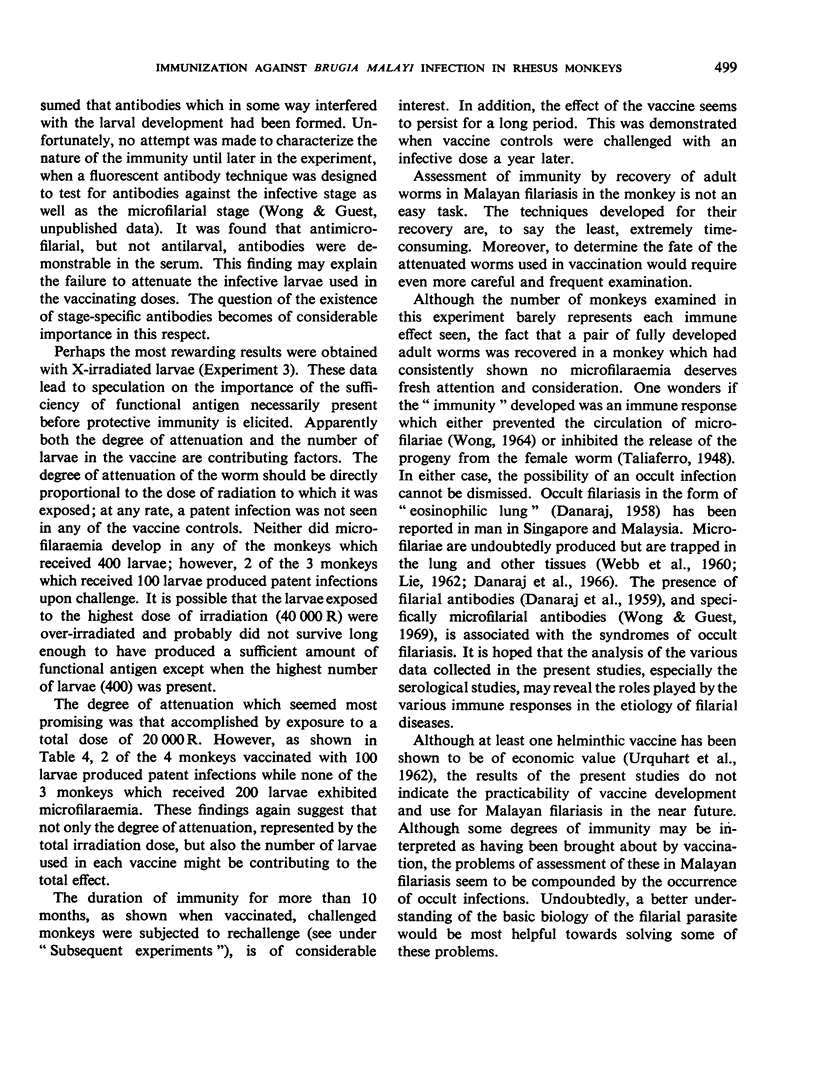
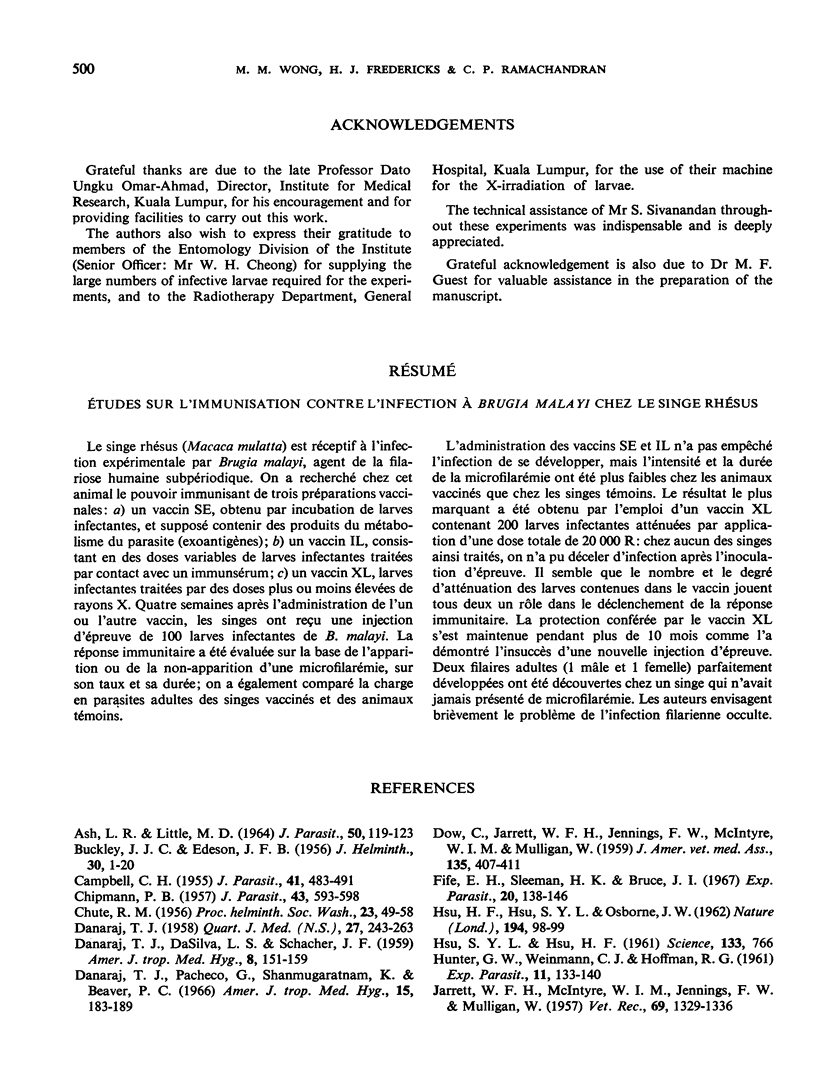
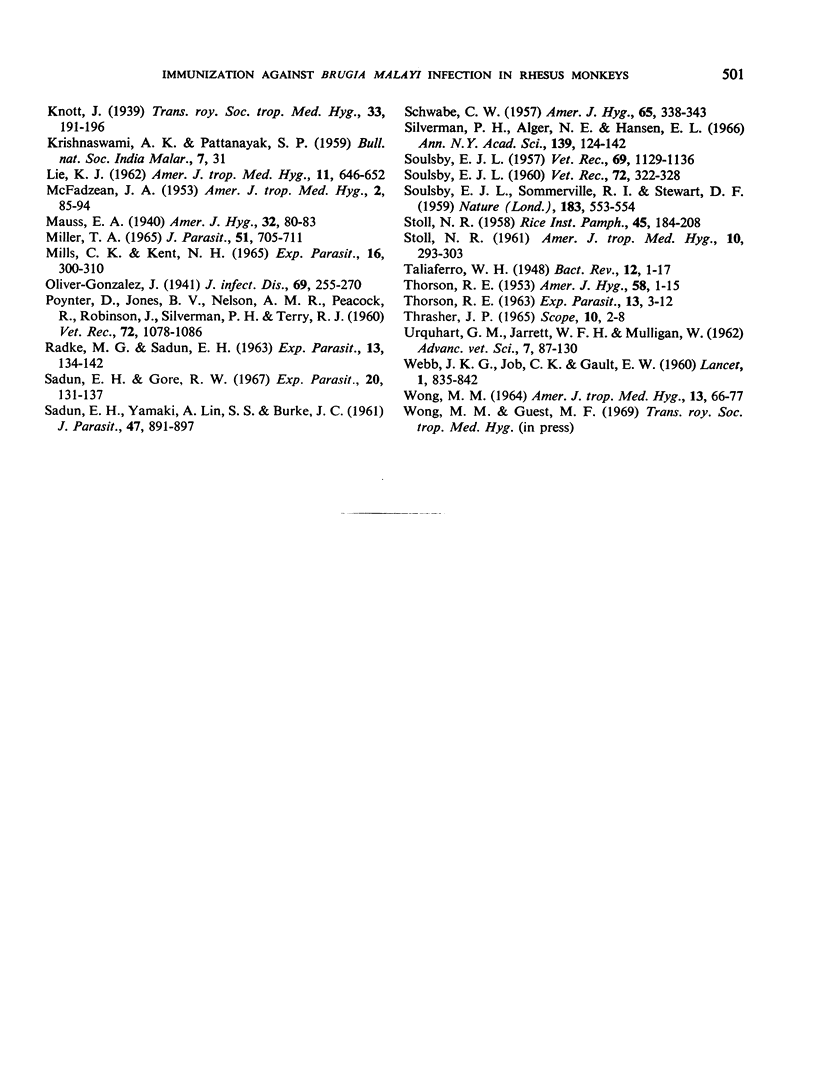
Selected References
These references are in PubMed. This may not be the complete list of references from this article.
- ASH L. R., LITTLE M. D. BRUGIA BEAVERI SP. N. (NEMATODA: FILARIOIDEA) FROM THE RACCOON (PROCYON LOTOR) IN LOUISIANA. J Parasitol. 1964 Feb;50:119–123. [PubMed] [Google Scholar]
- BUCKLEY J. J., EDESON J. F. On the adult morphology of Wuchereria sp. (malayi?) from a monkey (Macaca irus) and from cats in Malaya, and on Wuchereria pahangi n.sp. from a dog and a cat. J Helminthol. 1956;30(1):1–20. doi: 10.1017/s0022149x00032922. [DOI] [PubMed] [Google Scholar]
- CAMPBELL C. H. The antigenic role of the excretions and secretions of Trichinella spiralis in the production of immunity in mice. J Parasitol. 1955 Oct;41(5):483–491. [PubMed] [Google Scholar]
- CHIPMAN P. B. The antigenic role of the excretions and secretions of adult Trichinella spiralis in the production of immunity in mice. J Parasitol. 1957 Dec;43(6):593–598. [PubMed] [Google Scholar]
- DANARAJ T. J., DA SILVA L. S., SCHACHER J. F. The serological diagnosis of eosinophilic lung (tropical eosinophilia) and its etiological implications. Am J Trop Med Hyg. 1959 Mar;8(2 Pt 1):151–159. doi: 10.4269/ajtmh.1959.8.151. [DOI] [PubMed] [Google Scholar]
- DANARAJ T. J. The treatment of eosinophilic lung (tropical eosinophilia) with diethylcarbamazine. Q J Med. 1958 Apr;27(106):243–263. [PubMed] [Google Scholar]
- DOW C., JARRETT W. F., JENNINGS F. W., McINTYRE W. I., MULLIGAN W. The production of active immunity against the canine hookworm Uncinaria stenocephala. J Am Vet Med Assoc. 1959 Oct 15;135:407–411. [PubMed] [Google Scholar]
- Danaraj T. J., Pacheco G., Shanmugaratnam K., Beaver P. C. The etiology and pathology of eosinophilic lung (tropical eosinophilia). Am J Trop Med Hyg. 1966 Mar;15(2):183–189. doi: 10.4269/ajtmh.1966.15.183. [DOI] [PubMed] [Google Scholar]
- Fife E. H., Jr, Sleeman H. K., Bruce J. I., Jr Isolation and characterization of a serologically active exoantigen of Schistosoma mansoni cercariae. Exp Parasitol. 1967 Apr;20(2):138–146. doi: 10.1016/0014-4894(67)90032-x. [DOI] [PubMed] [Google Scholar]
- HSU H. F., HSU S. Y., OSBORNE J. W. Immunization against Schistosoma japonicum in rhesus monkeys produced by irradiated cercariae. Nature. 1962 Apr 7;194:98–99. doi: 10.1038/194098a0. [DOI] [PubMed] [Google Scholar]
- HSU S. Y., HSU H. F. New approach to immunization against Schistosoma japonicum. Science. 1961 Mar 17;133(3455):766–766. doi: 10.1126/science.133.3455.766. [DOI] [PubMed] [Google Scholar]
- HUNTER G. W., WEINMANN C. J., HOFFMANN R. G. Studies on schistosomiasis. XVII. Non-reciprocal acquired resistance between Schistosoma mansoni and Schistosomatium douthitti in mice. Exp Parasitol. 1961 Sep;11:133–140. doi: 10.1016/0014-4894(61)90018-2. [DOI] [PubMed] [Google Scholar]
- MCFADZEAN J. A. Immunity in filariasis of experimental animals. Am J Trop Med Hyg. 1953 Jan;2(1):85–94. doi: 10.4269/ajtmh.1953.2.85. [DOI] [PubMed] [Google Scholar]
- MILLS C. K., KENT N. H. EXERETIONS AND SECRETIONS OF TRICHINELLA SPIRALIS AND THEIR ROLE IN IMMUNITY. Exp Parasitol. 1965 Jun;16:300–310. doi: 10.1016/0014-4894(65)90051-2. [DOI] [PubMed] [Google Scholar]
- Miller T. A. Persistence of immunity following double vaccination of pups with x-irradiated Ancylostoma caninum larvae. J Parasitol. 1965 Oct;51(5):705–711. [PubMed] [Google Scholar]
- RADKE M. G., SADUN E. H. Resistance produced in mice by exposure to irradiated Schistosoma mansonicercariae. Exp Parasitol. 1963 Apr;13:134–142. doi: 10.1016/0014-4894(63)90063-8. [DOI] [PubMed] [Google Scholar]
- SADUN E. H., YAMAKI A., LIN S. S., BURKE J. C. Studies on the host-parasite relationships to Schistosoma japonicum. VI. Acquired resistance in mice and monkeys infected with the Formosan and Japanese strains. J Parasitol. 1961 Dec;47:891–897. [PubMed] [Google Scholar]
- SCHWABE C. W. Effects of normal and immune rat sera upon the respiration of free-living and parasitic Nippostrongylus muris larvae. Am J Hyg. 1957 May;65(3):338–343. doi: 10.1093/oxfordjournals.aje.a119873. [DOI] [PubMed] [Google Scholar]
- SOULSBY E. J., SOMMERVILLE R. I., STEWART D. F. Antigenic stimulus of exsheathing fluid in self-cure of sheep infested with Haemonchus contortus. Nature. 1959 Feb 21;183(4660):553–554. doi: 10.1038/183553b0. [DOI] [PubMed] [Google Scholar]
- Sadun E. H., Gore R. W. Relative sensitivity and specificity of soluble antigens (metabolic and somatic) and whole cercariae in fluorescent antibody tests for schistosomiasis in humans and rabbits. Exp Parasitol. 1967 Apr;20(2):131–137. doi: 10.1016/0014-4894(67)90031-8. [DOI] [PubMed] [Google Scholar]
- Silverman P. H., Alger N. E., Hansen E. L. Axenic helminth cultures and their use for the production of antiparasitic vaccines. Ann N Y Acad Sci. 1966 Oct 7;139(1):124–142. doi: 10.1111/j.1749-6632.1966.tb41191.x. [DOI] [PubMed] [Google Scholar]
- THORSON R. E. Seminar on immunity to parasitic helminths. II. Physiology of immunity to helminth infections. Exp Parasitol. 1963 Feb;13:3–12. doi: 10.1016/0014-4894(63)90050-x. [DOI] [PubMed] [Google Scholar]
- THORSON R. E. Studies on the mechanism of immunity in the rat to the nematode, Nippostrongylus muris. Am J Hyg. 1953 Jul;58(1):1–15. doi: 10.1093/oxfordjournals.aje.a119584. [DOI] [PubMed] [Google Scholar]
- Taliaferro W. H. THE INHIBITION OF REPRODUCTION OF PARASITES BY IMMUNE FACTORS. Bacteriol Rev. 1948 Mar;12(1):1–17. doi: 10.1128/br.12.1.1-17.1948. [DOI] [PMC free article] [PubMed] [Google Scholar]
- WEBB J. K., JOB C. K., GAULT E. W. Tropical eosinophilia: demonstration of microfilariae in lung, liver, and lymphnodes. Lancet. 1960 Apr 16;1(7129):835–842. doi: 10.1016/s0140-6736(60)90730-3. [DOI] [PubMed] [Google Scholar]
- WONG M. M. STUDIES ON MICROFILAREMIA IN DOGS. II. LEVELS OF MICROFILAREMIA IN RELATION TO IMMUNOLOGIC RESPONSES OF THE HOST. Am J Trop Med Hyg. 1964 Jan;13:66–77. [PubMed] [Google Scholar]


